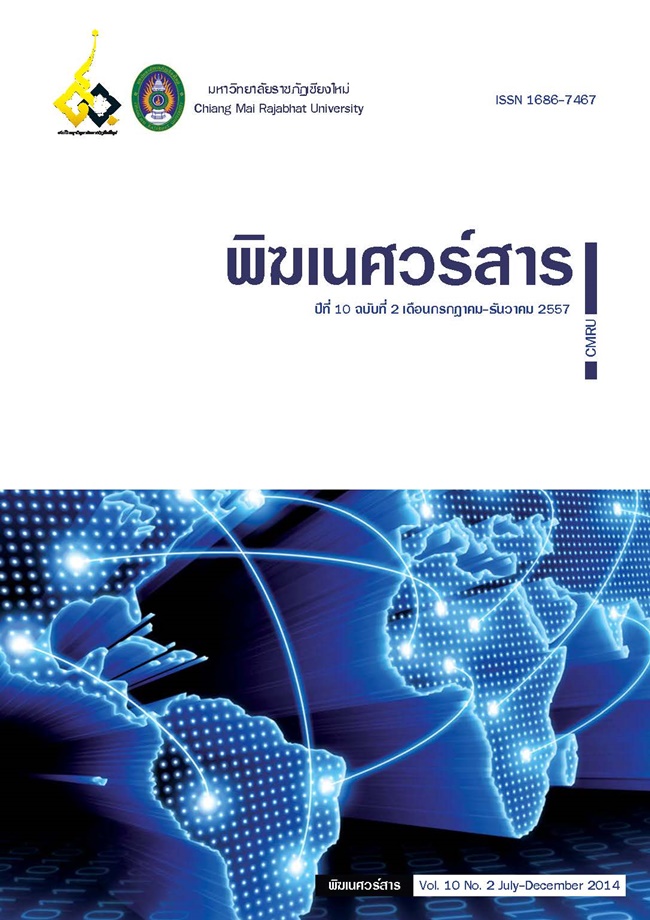การเปลี่ยนแปลงคุณภาพทางเคมี กายภาพ และจุลชีววิทยา ของน้ำมันงาบีบร้อนและบีบเย็นในสภาวะเร่ง
Main Article Content
Abstract
น้ำมันงา (sesame oil) เป็นน้ำมันที่นิยมกันมากในปัจจุบันสำหรับผู้บริโภคที่สนใจเรื่องสุขภาพ การผลิตน้ำมันงานั้น มีทั้งการบีบร้อน (hot pressing) และ การบีบเย็น (cold pressing) ในงานวิจัยนี้เป็นการตรวจสอบน้ำมันงาทั้ง 2 ชนิด โดยการบรรจุน้ำมันงาใส่ในขวดแก้วขนาด 50 มิลลิลิตร เก็บตัวอย่างไว้ที่อุณหภูมิ 5 , 25 , 35 , 45 และ 55 องศาเซลเซียส ตรวจสอบการเปลี่ยนแปลงค่า Acid value , Peroxide valueและ Moisture ในทุกๆ 10 วันสำหรับผลิตภัณฑ์น้ำมันงาที่จัดเก็บในอุณหภูมิ 5 , 25 และ 35 องศาเซลเซียส ทุกๆ 7 วันสำหรับผลิตภัณฑ์น้ำมันงาที่จัดเก็บในอุณหภูมิ 45 และ 55 องศาเซลเซียส และตรวจสอบ Total plate count, Coliforms Bacteria, Yeast and molds, Clostridium perfringens, Salmonella spp. , Bacillus cereus และ Staphylococcus aureus ในน้ำมันงาทั้ง 2 ชนิด เมื่อสิ้นสุดการทดลองในทุกช่วงอุณหภูมิของการจัดเก็บ ใช้ระยะเวลา100 และ 70 วัน ปริมาณค่า AV ที่ได้มีการเปลี่ยนแปลงเพียงเล็กน้อยในน้ำมันงาทั้งบีบร้อนและบีบเย็น เมื่อเวลาผ่านไปที่อุณหภูมิ 5 องศาเซลเซียส ค่า AV จาก 1.504 เพิ่มเป็น 2.680 mg KOH/g และ1.875 เพิ่มเป็น 3.160 mg KOH/g ในอุณหภูมิการจัดเก็บที่สูงขึ้นจะเกิดการเปลี่ยนแปลงเร็วขึ้น ในน้ำมันงาบีบร้อนจะมีค่า AVเท่ากับ 2.621 , 2.523 , 3.552 และ 3.672 mg KOH/g ตามลำดับ และในน้ำมันงาบีบเย็น ได้ค่า AV เท่ากับ 3.129 , 3.224 , 3.421 และ 3.441 mg KOH/g ตามลำดับเช่นกัน ในการทดสอบค่า PV ผลิตภัณฑ์น้ำมันงา น้ำมันงาบีบเย็นเกิดการเปลี่ยนแปลงอย่างรวดเร็วจนที่อุณหภูมิ 55 องศาเซลเซียส ค่า PV ที่ได้เปลี่ยนแปลงจากเริ่มต้นที่ 0.00 เป็น 11.870 mEq/kg ในวันที่สิ้นสุดของการจัดเก็บ ซึ่งค่าที่ได้เกินกว่าที่กฎหมายได้กำหนดไว้ ทั้งนี้ผลที่ได้แตกต่างอย่างเห็นได้ชัดเจนในน้ำมันงาบีบร้อน ค่า PV จะเปลี่ยนแปลงไปจากเดิมเพียงเล็กน้อยจาก 0.00 เป็น 2.617 mEq/kg และที่อุณหภูมิ 5 องศาเซลเซียส ค่า PV จะเพิ่มขึ้นช้ากว่าเมื่อเทียบกับอุณหภูมิที่สูง โดยเพิ่มจาก 0.00 เป็น 1.72 mEq/kg ในน้ำมันงาบีบร้อน และ 5.58 mEq/kg ในน้ำมันงาบีบเย็น ส่วนค่าความชื้นน้ำมันงาบีบร้อนที่เกิดขึ้นจากการทดลอง จะแปรผันตามอุณหภูมิที่จัดเก็บที่เพิ่มขึ้น โดยเพิ่มจากร้อยละ 0.130 เป็น 0.233 , 0.289 , 0.322 , 0.310 , 0.311 ตามลำดับอย่างมีนัยสำคัญ (P≤0.05) เช่นเดียวกับน้ำมันงาบีบเย็น จะเพิ่มจากร้อยละ 0.128 เป็น 0.233 , 0.292 , 0.290 , 0.311 , 0.310 ตามลำดับ ซึ่งมีความแตกต่างกันอย่างมีนัยสำคัญ (P≤0.05) และในการทดสอบทางด้านเชื้อจุลินทรีย์ ผลที่ได้ไม่พบการเจริญเติบโตที่เกินกว่ากฎหมายกำหนด ทั้งในน้ำมันงาที่บีบร้อนและบีบเย็นไม่ว่าจะเก็บในอุณหภูมิสูงหรือต่ำ ก็ตามจากผลการทดลองสรุปได้ว่าในการจัดเก็บน้ำมันงาเพื่อป้องกันการเสื่อมเสียทางด้านคุณภาพนั้น ควรจัดเก็บที่อุณหภูมิต่ำจะช่วยยืดอายุการเก็บรักษาน้ำมันงาไว้ได้ดีที่สุดทั้งน้ำมันงาบีบร้อนและน้ำมันงาบีบเย็น แต่ระยะเวลาในการจัดเก็บที่เพิ่มขึ้น มีผลต่อการเสื่อมเสียคุณภาพของน้ำมันงาเช่นกัน โดยเฉพาะอย่างยิ่ง น้ำมันงาบีบเย็น
CHEMICAL, PHYSICAL AND MICROBIOLOGICAL CHANGES OF ROAST SESAME OIL AND COLD SESAME OIL IN ACCELERATED CONDITION
Sesame oil is very popular nowadays among the health care consumers. The edible vegetable oil can be produced by the hot or cold pressing processes. This research investigated the change in product qualities in terms of acid values (AV), peroxide values (PV) and moisture content of sesame oil extracted by the two methods. The constant volume of oil (50 mL) in glass bottles was incubated in a variety of temperature conditions (5, 25, 35 45 and 55oC) for 100-day period. The chemical analysis of oil products stored at 45 and 55oC were evaluated every week while the samples kept at lower temperatures were sampling every 10 days. The microbiological analysis of total plate count, coliforms bacteria including yeast and molds also the product safety from foodborne pathogens, Clostridium perfringens, Salmonella spp., Bacillus cereus and Staphylococcus aureus was determined at the end of the experiment in all temperatures of storage period. There had a slightly increase in AV values at 5oC of hot pressed condition from 1.504 to 2.680 mg KOH/g and cold pressed treatment from 1.875 to 3.160 mg KOH/g. The high storage temperatures accelerated the change in AV parameter of hot pressed oil resulting in the values of 2.621, 2.523, 3.552 and 3.676 mg KOH/g similarly to the outcome of cold treated oil presented 2.621, 2.523, 3.552 and 3.672 mg KOH/g respectively. At 55oC, a rapid increment of PV value by 11.8 mEq/kg was reported in cold pressed product overtime and still exceeded the food standard whereas the hot process affected to the value up to 2.617 mEq/kg only. The low storage temperature had a remarkable deceleration the PV. The noticeable different in PV contents of hot pressed sample incubated at 5oC was also relative high, 5.58 mEq/kg in comparison to 1.72 mEq/kg found in cold extraction. The moisture content of hot pressed oil caused by the storage test was proportional increase to the elevated temperature from the initial value, 0.130 mEq/kg as statistically significantly (p<0.05) up to 0.233, 0.289, 0.322, 0.310 and 0.311, respectively. The PV of cold press sesame oil were shown a statistically different (p<0.05) rising from the control, 0.128 upward to 0.233, 0.292, 0.290, 0.311 and 0.310, respectively. Furthermore, the microbial quality and safety both hot and cold treated samples sampling from the five storage temperatures was not growing in excess of the standard limit. The research shows that low temperature is an effective storage condition to prevent the chemical instability and deterioration of the oil processed by both two pressing methods. However, the duration of observation storage has no effect on the sesame oil quality pressed by the cold preparation.
Downloads
Article Details
The articles published are copyrighted by the Graduate School, Chiang Mai Rajabhat University.
The opinions expressed in each article of this academic journal are solely those of the individual authors and do not reflect the views of Chiang Mai Rajabhat University or its faculty members. The responsibility for the content of each article rests entirely with the respective authors. In the event of any errors, the authors alone are responsible for their own articles.


